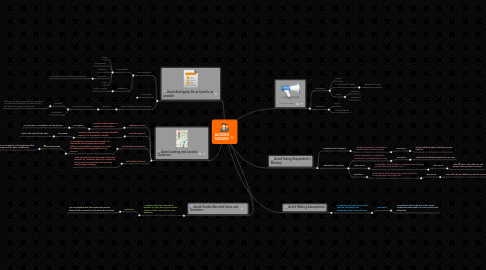
1. Avoid Double-Barreled Items and Questions
1.1. A question that may induce bias because it covers two or more issues at once. It also covers two or more questions.
1.1.1. EXAMPLE
1.1.1.1. Are you satisfied with the prices and services offered at the university in the Rosarista's Home?
2. Avoid Ambiguity: Be as Specific as possible
2.1. Questionnaires
2.1.1. Too general
2.1.1.1. Often
2.1.1.2. Occasionally
2.1.1.3. Regularly
2.1.1.4. Frequently
2.1.1.4.1. All words has many different meanings,
2.1.1.5. Many
2.1.2. Ambiguous
2.1.2.1. Online Activity
2.2. Perception
2.2.1. Explicit
2.2.1.1. 1
2.2.1.2. 2
2.2.1.3. 3
2.2.2. Implicit
2.2.2.1. A
2.2.2.2. B
2.2.2.3. C
2.2.3. Follow Up Process
2.2.3.1. 1A
2.2.3.1.1. Contact within 24 Hours
2.2.3.2. 1B
2.2.3.2.1. Contact within 72 Hours
2.2.3.3. 1C, 2A, 2B
2.2.3.3.1. To be contacted, usually by an inside sales agent.
2.2.3.4. 2C, 3
2.2.3.4.1. Not contacted
2.3. Rate of diffusion of an innovation
2.3.1. Depends
2.3.1.1. Perception of product
2.3.1.1.1. Divisible
2.3.1.1.2. Not divisible
3. Avoid Leading and Loaded Questions
3.1. Leading questions
3.1.1. Questions that suggests or implies certain answers
3.1.1.1. EXAMPLE:
3.1.1.1.1. Do you have any problems with your boss?
3.2. Loaded questions
3.2.1. Questions that suggests a socially desirable answer or is emotionally charged.
3.2.1.1. EXAMPLE:
3.2.1.1.1. Where did you hide the gun?
3.3. Counterbiasing statement
3.3.1. An introductory statement or preamble to a potentially embarassing question that reduces a respondent's reluctance to answer by suggesting that certain behavior is no unusual
3.3.1.1. NO RESPONSE
3.3.1.1.1. Solution is to explain at the beginning that the answers will be kept confidencial.
3.4. Split-ballot technique
3.4.1. Using two alternatives phrasings of the same question for respective halves of a sample to elicit a more accurate total response than would a single phrasing
4. Simpler is Better
4.1. Vocabulary
4.1.1. Simple
4.1.2. For all kind of people
4.1.2.1. Educational level
4.1.3. Avoid
4.1.3.1. Problems
4.1.3.2. Complexity
4.2. Questions
4.2.1. Short
4.2.2. Understandable
5. Avoid Making Assumptions
5.1. A question that takes for granted that the respondent has knowledge about a specific topic.
5.1.1. EXAMPLE
5.1.1.1. According to the third point of the Peace Agreemets what would you have voted in the Plebiscite?
6. Avoid Taxing Respondent's Memory
6.1. Unaided Recall Questions
6.1.1. Asking respondents to remember something to provide any clue
6.1.1.1. EXAMPLE
6.1.1.1.1. Tell me all the brands of clothes you can think of.
6.2. Aided Recall Questions
6.2.1. Asking respondents to remember something by providing them a clue
6.2.1.1. EXAMPLE
6.2.1.1.1. Which of the following brands do you use?
6.2.2. Telescoping
6.2.2.1. Respondents believe that past events happened more recently than they actually occur
6.2.2.1.1. EXAMPLE
6.2.3. Squishing
6.2.3.1. Respondents think that recent events took place longer ago than they really did.
6.2.3.1.1. EXAMPLE
